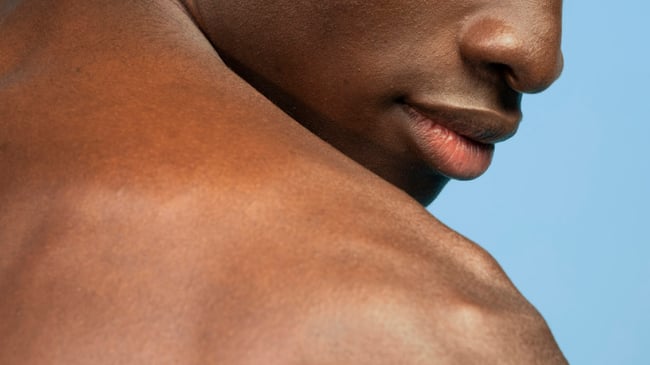

How to prevent and soothe peeling skin
Words Matthieu Morge-Zucconi
Share the article on
Take care of your sunburned skin
It’s a situation we’ve all experienced at least once. You’re snoozing in the sun, lulled to sleep by the soothing sound of waves breaking against the shore. You wake up burned to a crisp. This is quickly followed by peeling, the natural and common consequence of severe sunburns. Skin peeling is annoying, and frankly doesn’t look very good. Read on to learn how to get rid of it.
Peeling — also known as desquamation — is a natural phenomenon occurring during cell renewal. Sunburns will emphasise this phenomenon, leading to dead cells detaching from your skin in larger portions. Like a snake shedding its skin, in a way. While allergic reactions or psoriasis can also make peeling worse, sunburns are the most frequent cause of large-scale desquamation.
How to avoid peeling
Before exposing your skin to the sun, there are a few steps you can take to control peeling. First off, it is recommended to thoroughly exfoliate your skin before going off on holiday. Refreshed and freed from its dead cells, your skin will be able to take on a much more uniform tan.
When you (finally) start taking in the sun, be sure to follow the same precautions as usual: wear sunscreen, and avoid exposing your skin to the sun during the early afternoon hours. The sun’s rays are extremely powerful during this period, and the risk of getting burned and peeling is obviously much higher.
In spite of this advice, sunburns happen. All it takes is a little carelessness or bad luck, and you end up simply red, word to Mick Hucknall. When this happens, simply follow the steps below.
What to do when it’s already too late
Moisturise, moisturise, and moisturise again
A sunburn often comes with dehydration. Drink a lot to fill up on fluids and keep your skin moisturised. This will help the skin self-accelerate the healing process. Eating watermelon will help with hydration too. It contains vitamin C, which boosts damaged skin cell renewal.
Avoid hot showers
While it is true that cold showers are the best means of cooling down in warm temperatures, hot showers should also be avoided because they tend to make the skin drier, hence exacerbating the peeling. Stick to cold or lukewarm showers, with a moisturising shower gel.
Don’t exfoliate
We understand how tempting it is to remove all the dead skin cells when you’re peeling. Please don’t. This will only make the situation worse and further damage your weakened skin. Trust us, it’s not worth trying to shed your skin at any cost.
Refrain from pulling off the peeling skin
This one is really common sense, but you never know... Don’t ever pull off your peeling skin. Let nature do its job alone. It won’t need your help to shed dead skin, and pulling it off could lead to poor healing as well as disrupt the cell renewal process.
Use after-sun lotion
Use after-sun lotion as often as possible, and as much as you like, to provide your skin with the deep moisturising it needs. After-sun lotions are particularly nourishing, and therefore extremely effective for sunburned skin. They often contain soothing agents such as aloe vera, that will help calm the burning sensation. As regular body lotions don’t always contain such ingredients, using after-sun lotion is your safest bet for a speedy recovery. Don’t be scared to put a double dose of lotion on the areas of your skin that are peeling.
Stick to the shade (and stay covered)
After sunburn and with your skin peeling, we cannot recommend enough that you stay out of the sun for a while. Wear a hat and a shirt to protect your skin from the sun’s more powerful rays, and never go out without your sunscreen. Sunburned skin is damaged and therefore far more sensitive to UV radiation.
You’re now ready to shed your old, burned skin, for a new one. Just try not to repeat the same mistake.